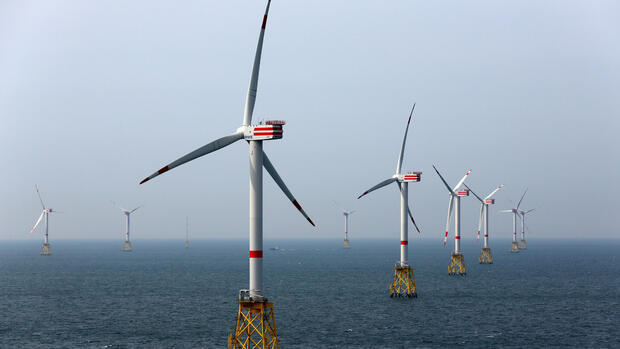The gas network operators are now demanding that the North Sea countries provide the appropriate legal and regulatory framework.
(Photo: dpa)
Berlin The North Sea should develop into the “power plant of Europe”. According to EU plans, wind turbines with a capacity of 150 gigawatts (GW) are to be installed in the North Sea by 2050. Part of the wind power is to be used to produce hydrogen on the high seas.
Nine European long-distance gas pipeline operators have now committed themselves to building the pipeline infrastructure for transporting the hydrogen. The declaration is available to the Handelsblatt. On the German side, the companies Open Grid Europe (OGE) and Gascade are involved. Gascade is owned by oil and gas producer Wintershall Dea and gas company Sefe. Sefe is owned by the federal government.
The nine gas network operators have signed a declaration in which they announce that they will convert existing gas pipelines for hydrogen transport and also build new hydrogen pipelines. To do this, they want to closely coordinate their plans.
The addressees of the declaration are the governments of the countries bordering the North Sea, whose representatives are meeting in Ostend, Belgium, for the “North Sea Summit 2023” at the beginning of next week.
The summit is the follow-up event to a meeting in Esbjerg, Denmark last May, which Chancellor Olaf Scholz (SPD) attended. On this occasion, the government representatives of the North Sea countries agreed on ambitious goals for the expansion of wind power and the development of the associated infrastructure.
Appropriate legal and regulatory framework
The gas network operators are now demanding that the North Sea countries provide the appropriate legal and regulatory framework. In addition, approval procedures would have to be accelerated and financing issues between the federal states would have to be clarified.
>>Read here: How do you transport green hydrogen to Germany?
Gascade Managing Director Christoph von dem Bussche said that “integrated, cross-border grid planning for the future use of offshore wind energy for electricity and hydrogen production” was required in the near future. “The advantages are obvious: ensuring future security of supply and diversification of Europe’s energy supply.”
The core of a future hydrogen network infrastructure in the North Sea is already emerging: Gascade and the Belgian gas network operator Fluxys, which has a stake in OGE and is also one of the signatories to the declaration, are currently driving the Aquaductus project forward.
This is a 200-kilometer line in the North Sea that will initially connect wind farms in the German North Sea with the German mainland by 2030. After that, the expansion is to take place: Aquaductus is to be linked to hydrogen pipelines from countries bordering the North Sea.
More: The mega project – How a European hydrogen infrastructure is taking shape
